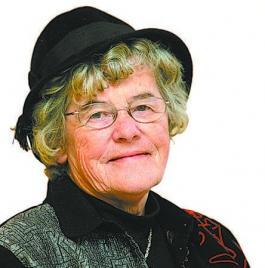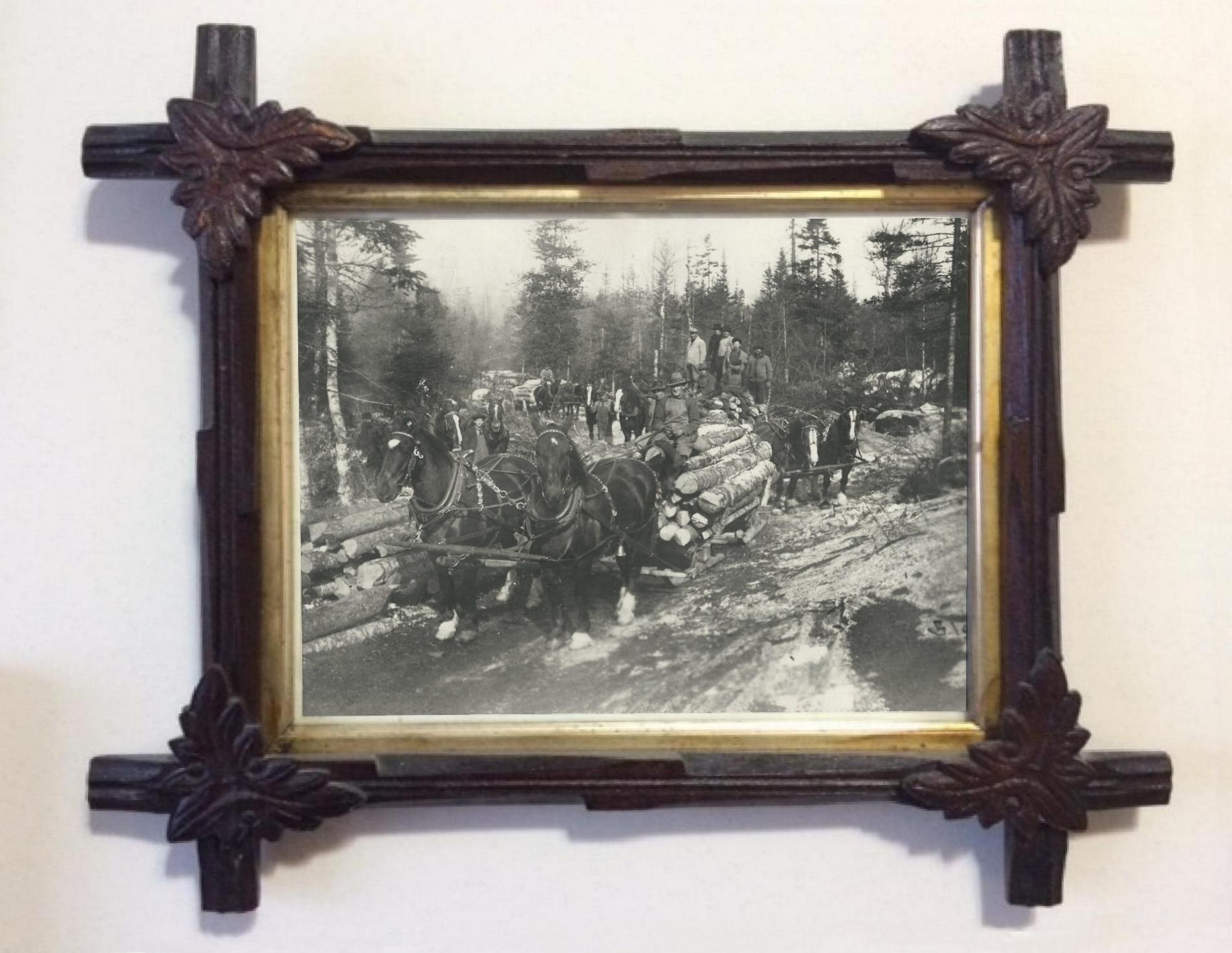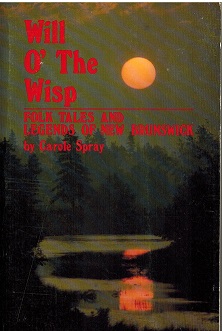
Ruby M. Cusack

Teams of horses hauling axe chopped logs. Circa 1920s (From the Floyd Collection)
WILL O' THE WISP
FOLK TALES AND LEGENDS OF NEW BRUNSWICK
FOLK TALES AND LEGENDS OF NEW BRUNSWICK
by Carole Spray
It was only mid January but the adults were complaining it was a hard winter with a variety of weather from sunny days of the eaves dripping to stretches of bitter cold with howling winds and lots of snow.
The storm yesterday commenced with snow, turned to rain and then the red in the thermometer went way down which made a crust on the snow that we could walk on.
Tonight was a beautiful evening with a full moon. We could see almost like it was daylight.
We convinced Mom to let us take our ski runner sleds and go to the top of the hill behind the Church which was really steep but short. Her final warning was to be careful as several years ago one of the Kilpatrick boys had broken his arm while coasting on that hill.
Since there were few cars, if any on the road, we didn’t see any reason we could not walk to the top of Stover’s hill, which would give us a great long run and right through the covered bridge and probably almost to our driveway. Furthermore, we didn’t think Mum would ever find out.
On about our fourth trip of hauling our sleds up the hill, we heard a terrible scream coming from the area of the Lake Road. We stopped and listened. The next scream was much louder and seemed closer. That is when Cliff and I took off running, as we were scared to death. We thought an Indian Devil, sometimes known as a lucifer or panther was about to attack us.
We ran into the house not even thinking of removing our snow-covered boots. With shaking voices and close to tears, we told Mum of our terrible scare.
Gramp remarked, “Maybe it was the Dungarvon Whooper.”
I didn’t have a clue what he was talking about and thought he was making fun of us.
Carole Spray spent four years or more collecting forty folktales for her 1979 publication titled “Will O' The Wisp - Folk Tales and Legends of New Brunswick”.
One of the very interesting stories concerns the death of a fellow named Ryan, who came into the lumber camp near the Dungarvon River and hired on as a cook. He had all his worldly goods with him, including a rooster to act as his alarm clock. Around his waist was fastened a money-belt filled with coins and paper money.
The cook died under suspicious circumstances with the money belt disappearing. Due to a snow storm, his body was buried in the forest. That was when the screaming commenced. Sometime later, Father Murdoch of Renous came to the grave, read some holy words from the Bible and made the sign of the cross.
The screeching and fearful cries can still be heard today. Some folk think it could be the spine-chilling shriek of a panther but others think the Dungarvon Whooper is the ghost of Ryan.
Other tales in the book, include Old Sham from the Hoyt, Wirral and Bayard’s Camp that revolves around a bear that was very difficult to eliminate and a trap.
Selling your soul to the Devil seemed to be a favourite folklore for stories to grow from.
Jack Dyre was left behind aboard the “Union” to keep watch. The crew had rowed ashore to visit their families in St. Martins. Just after midnight he heard a voice three times commanding him to leave the ship. He was so upset that he cleared out very quickly. Fortunately he refused in the morning, to return to the schooner with the other crew members. Something really weird happened that day. The ship was picked up and dropped into the sea upside down, although the waters were calm and no wind was blowing.
Geordie Brown was born in Tracadie of Scottish parents in 1825. He was considered to be a loveable eccentric trapper who gladly shared his many folktales.
Also, included are the stories of:
The Woman, the Bishop and the Cow
Do You Want to Buy a Cow (near the Village of Lameque)
Gabe Acquin and the Prince of Wales (Right Honourable J. H. T. Manners-Sutton)
The Man Who Plucked the Gorbey
Three Gold Hairs From the Giant’s Back
The Maiden’s Sacrifice (Malecite legend)
Ke-Whis-Wask; The Little People
The Man With the Cloven Hoof (Bouctouche)
The School Master and the Devil
The Wizard of the Miramichi
Whitlock’s Ghost
The Red-Haired Girl
The Currie Mountain Treasure
The Burning Ship
The Keswick Valley Ghost
The Residence Ghost - Fredericton
Rescued From Purgatory and other Yarns and Tall Tales.
The men of the woods and logging camps have their own vocabulary. A Funky is a lumberman who constructs logging roads; a Marchen is a wonder tale about imaginary creatures; Popple is a poplar tree; A Shoepack is an ankle length leather boot with the bottoms sometimes dipped in molasses and oats to give a man better traction on the slippery ice.
Many a man left his wife and family at home to do the farming and housekeeping chores, while he spent the winter working in a lumber camp to earn some cash.
Every camp had a story teller or two along with a fiddler who entertained the men during the long evenings, either by telling tales, singing ballads or playing fiddling tunes.
It seems every family also has a storyteller or at least a family member who will relate stories from the past. Even if you doubt the truth in them, record these tales for future generations as much can be learned about the way life was lived in the days of yesteryear.

A used copy available for sale of Will O' The Wisp
http://www.rubycusack.com/Book-Wisp.html
Contact rmcusack@nbnet.nb.ca
Query 1879
Duplisea - Ramsay - White: My grandfather Charles Duplisea received a medal for bravery from the City of Saint John on May 5, 1932 for rescuing two boys from drowning at Long Wharf, Saint John, NB in 1930 and 1931 respectively. I’d be very interested in knowing about the boys as they grew to be men – they were nine year old Kenneth Ramsay, and three year old Gervois White. Would also like to find a picture of Charles Duplisea.
Email jhhovey@nb.sympatico.ca
Query 1880
Huestis - Pengilly: I am working on “Leaving the Asylum” a one woman play, based on the diary of Mary Huestis Pengilly which was written while she was a patient in the Provincial Lunatic Asylum in Saint John in 1883 - 1884.
After leaving the Asylum in 1884 Mary spent the rest of her life as The Traveling Poet selling her books of poetry and her published diary and advocating for the rights of persons living in psychiatric hospitals.
Mary is now celebrated as an advocate and author. The NB Mental Health Network honours her work with the Mary Huestis Pengilly activism award. We would like to make contact with relatives of Mary. Also seek information on the Huestis family.
Contact Normand P. Robichaud, author and a playwright at np_robichaud@hotmail.com
Query 1881
Brown: I have found an "Information Wanted" ad from the New Brunswick Courier date March 29, 1834, which states, “Jane Brown is very desirous of hearing from her Brothers Robert and James Brown, and some other relatives, with whom she arrived at Saint John, New Brunswick, in the Ann Comer, from Belfast, in June, 1831, and has not heard since of them. Direct to her, "Post Office, Saint John, New Brunswick."
We could not find if there was a reply to this ad, nor can we find the sailing of this ship. We are in hopes someone can give us some additional information on this family and the ad.
Contact jmb1955@earthlink.net
Query 1882
Barka’s 1965 Paper: I'm looking for a copy of Norman Barka's 1965 paper "Historic Sites Archaeology at Portland Point" which he wrote about his 1963 excavation of Fort La Tour in Saint John, New Brunswick. I would be willing to pay a reasonable amount for a decent copy. Contact mrbrussell@aol.com
**************

A used copy available for sale of Will O' The Wisp
http://www.rubycusack.com/Book-Wisp.html
Contact rmcusack@nbnet.nb.ca
|
New and Used Genealogical and Historical books of New Brunswick for sale. |
Back to Home of rubycusack dot com